Information Technology Management in ZARA: A Comprehensive Report
VerifiedAdded on 2023/01/12
|12
|3918
|89
Report
AI Summary
This report provides a comprehensive analysis of information technology (IT) management within ZARA, a global apparel retailer. It begins with an introduction to ZARA, its history, and its use of IT to enhance efficiency. The report then delves into an analysis of ZARA's competitive environment using Porter's Five Forces model, examining threats of new entry, substitution, bargaining power of suppliers and customers, and competitive rivalry. Furthermore, the report explores ZARA's value chain activities, focusing on inbound logistics, operations, and outbound logistics, highlighting how IT supports these activities. The analysis reveals ZARA's strong position in the industry, attributed to its effective IT strategies and efficient supply chain management. The report concludes with a reflection on the key findings and their implications for ZARA's continued success.
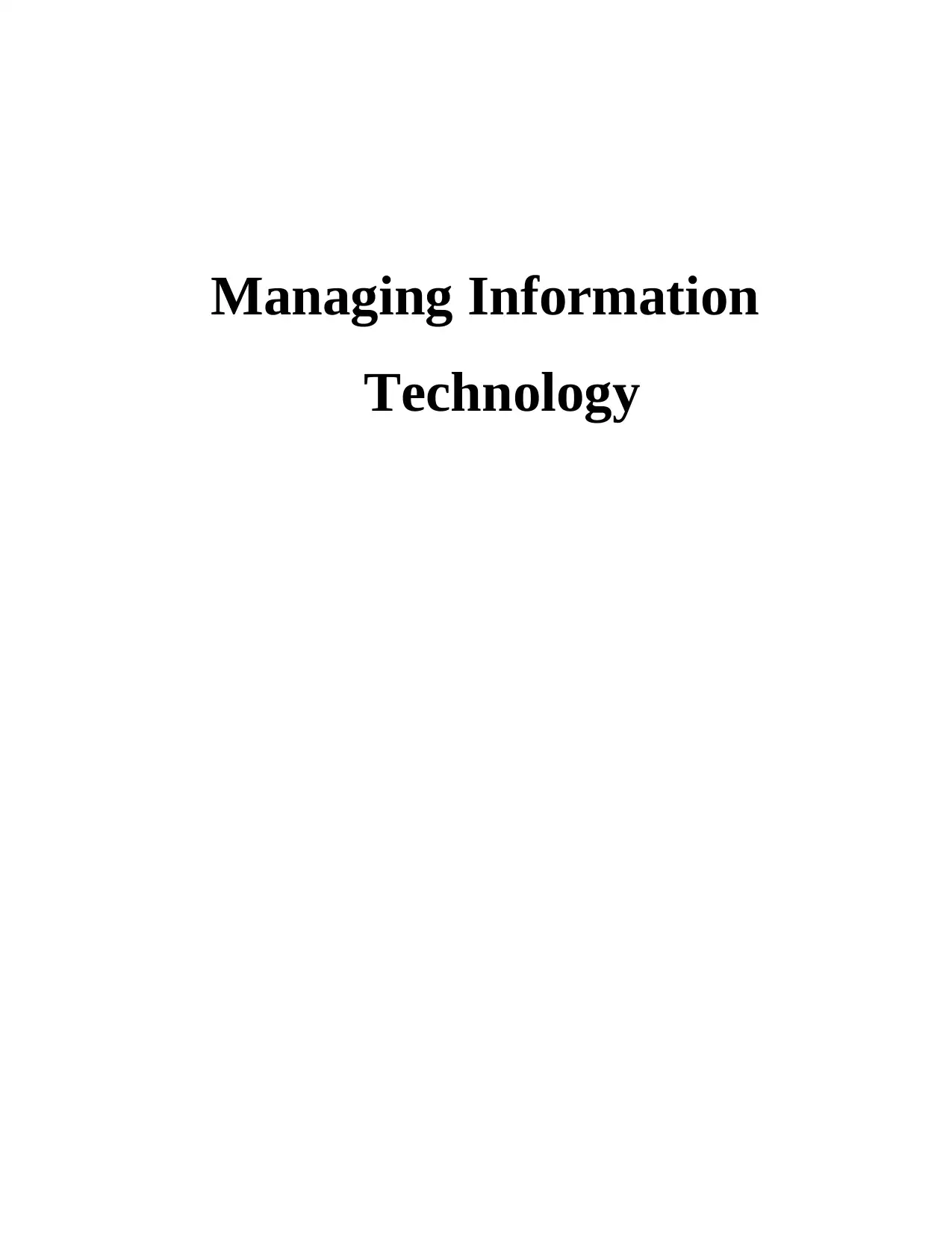
Managing Information
Technology
Technology
Paraphrase This Document
Need a fresh take? Get an instant paraphrase of this document with our AI Paraphraser
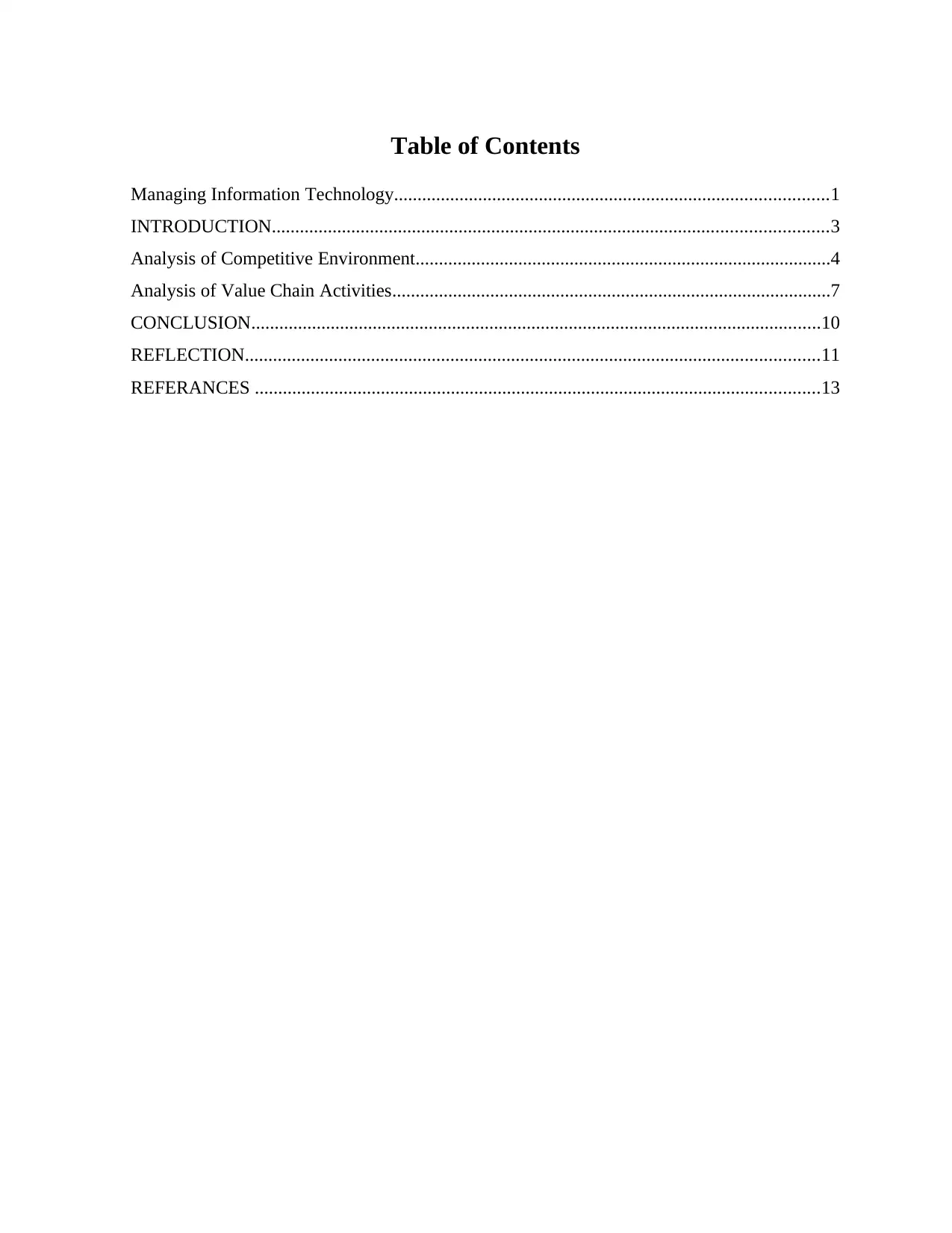
Table of Contents
Managing Information Technology.............................................................................................1
INTRODUCTION.......................................................................................................................3
Analysis of Competitive Environment.........................................................................................4
Analysis of Value Chain Activities..............................................................................................7
CONCLUSION..........................................................................................................................10
REFLECTION...........................................................................................................................11
REFERANCES .........................................................................................................................13
Managing Information Technology.............................................................................................1
INTRODUCTION.......................................................................................................................3
Analysis of Competitive Environment.........................................................................................4
Analysis of Value Chain Activities..............................................................................................7
CONCLUSION..........................................................................................................................10
REFLECTION...........................................................................................................................11
REFERANCES .........................................................................................................................13
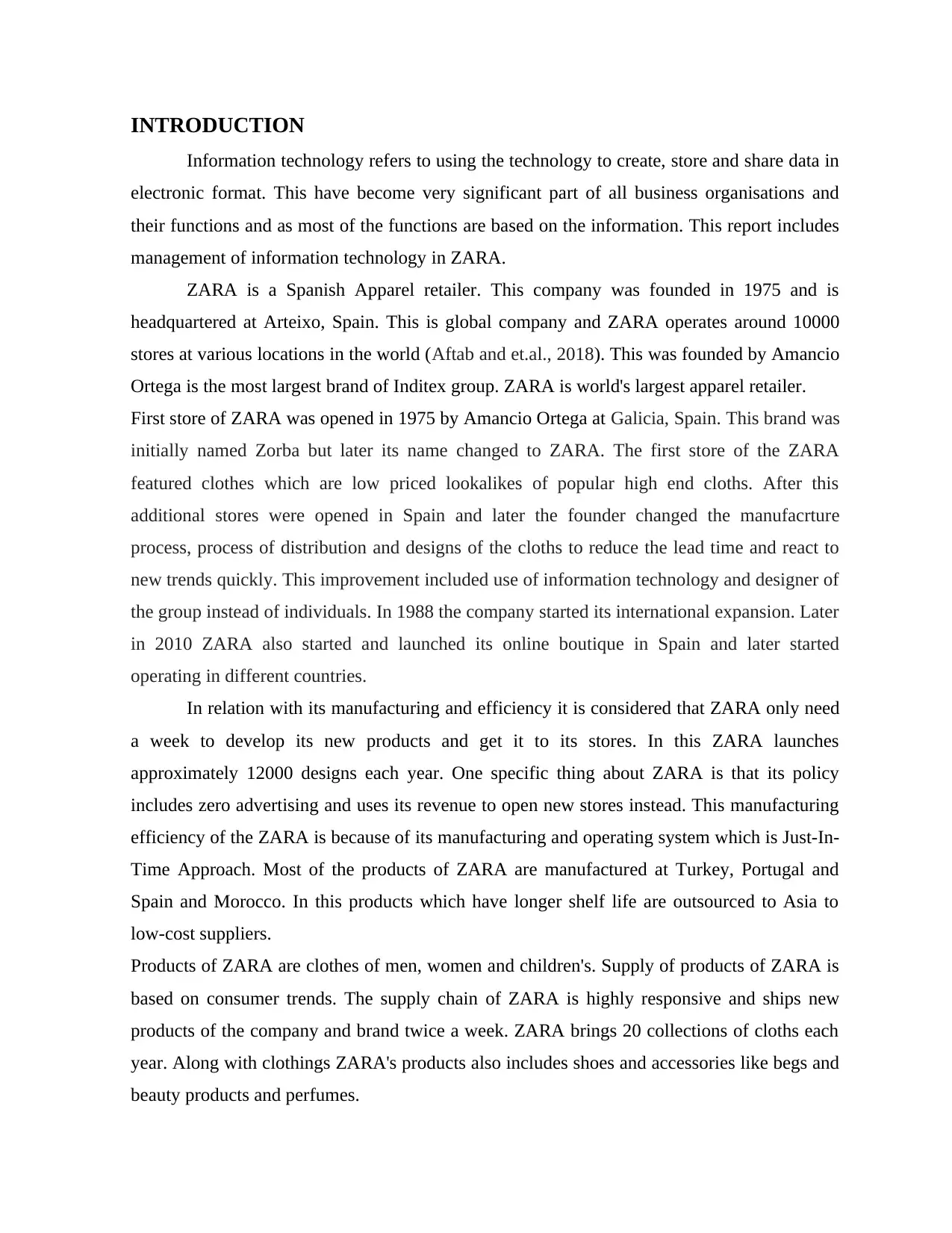
INTRODUCTION
Information technology refers to using the technology to create, store and share data in
electronic format. This have become very significant part of all business organisations and
their functions and as most of the functions are based on the information. This report includes
management of information technology in ZARA.
ZARA is a Spanish Apparel retailer. This company was founded in 1975 and is
headquartered at Arteixo, Spain. This is global company and ZARA operates around 10000
stores at various locations in the world (Aftab and et.al., 2018). This was founded by Amancio
Ortega is the most largest brand of Inditex group. ZARA is world's largest apparel retailer.
First store of ZARA was opened in 1975 by Amancio Ortega at Galicia, Spain. This brand was
initially named Zorba but later its name changed to ZARA. The first store of the ZARA
featured clothes which are low priced lookalikes of popular high end cloths. After this
additional stores were opened in Spain and later the founder changed the manufacrture
process, process of distribution and designs of the cloths to reduce the lead time and react to
new trends quickly. This improvement included use of information technology and designer of
the group instead of individuals. In 1988 the company started its international expansion. Later
in 2010 ZARA also started and launched its online boutique in Spain and later started
operating in different countries.
In relation with its manufacturing and efficiency it is considered that ZARA only need
a week to develop its new products and get it to its stores. In this ZARA launches
approximately 12000 designs each year. One specific thing about ZARA is that its policy
includes zero advertising and uses its revenue to open new stores instead. This manufacturing
efficiency of the ZARA is because of its manufacturing and operating system which is Just-In-
Time Approach. Most of the products of ZARA are manufactured at Turkey, Portugal and
Spain and Morocco. In this products which have longer shelf life are outsourced to Asia to
low-cost suppliers.
Products of ZARA are clothes of men, women and children's. Supply of products of ZARA is
based on consumer trends. The supply chain of ZARA is highly responsive and ships new
products of the company and brand twice a week. ZARA brings 20 collections of cloths each
year. Along with clothings ZARA's products also includes shoes and accessories like begs and
beauty products and perfumes.
Information technology refers to using the technology to create, store and share data in
electronic format. This have become very significant part of all business organisations and
their functions and as most of the functions are based on the information. This report includes
management of information technology in ZARA.
ZARA is a Spanish Apparel retailer. This company was founded in 1975 and is
headquartered at Arteixo, Spain. This is global company and ZARA operates around 10000
stores at various locations in the world (Aftab and et.al., 2018). This was founded by Amancio
Ortega is the most largest brand of Inditex group. ZARA is world's largest apparel retailer.
First store of ZARA was opened in 1975 by Amancio Ortega at Galicia, Spain. This brand was
initially named Zorba but later its name changed to ZARA. The first store of the ZARA
featured clothes which are low priced lookalikes of popular high end cloths. After this
additional stores were opened in Spain and later the founder changed the manufacrture
process, process of distribution and designs of the cloths to reduce the lead time and react to
new trends quickly. This improvement included use of information technology and designer of
the group instead of individuals. In 1988 the company started its international expansion. Later
in 2010 ZARA also started and launched its online boutique in Spain and later started
operating in different countries.
In relation with its manufacturing and efficiency it is considered that ZARA only need
a week to develop its new products and get it to its stores. In this ZARA launches
approximately 12000 designs each year. One specific thing about ZARA is that its policy
includes zero advertising and uses its revenue to open new stores instead. This manufacturing
efficiency of the ZARA is because of its manufacturing and operating system which is Just-In-
Time Approach. Most of the products of ZARA are manufactured at Turkey, Portugal and
Spain and Morocco. In this products which have longer shelf life are outsourced to Asia to
low-cost suppliers.
Products of ZARA are clothes of men, women and children's. Supply of products of ZARA is
based on consumer trends. The supply chain of ZARA is highly responsive and ships new
products of the company and brand twice a week. ZARA brings 20 collections of cloths each
year. Along with clothings ZARA's products also includes shoes and accessories like begs and
beauty products and perfumes.
⊘ This is a preview!⊘
Do you want full access?
Subscribe today to unlock all pages.

Trusted by 1+ million students worldwide

It was introduction of ZARA in relation with this report which is concerned with managing
information technology. This report includes analysis of competitive environment of ZARA
and this includes theory of Porter's five forces (Mayrhofer and Roederer, 2016). This also
includes analysis of ZARA's value chain analysis and identification of key value adding
activities for ZARA.
Analysis of Competitive Environment
Competitive environment of the company refers to environment which includes
competitive firms of the company and how these firms affect operations and activities of the
company. Many factors affect company and among all of them competitors are most
significant factor (Lewis, 2017). Competitors of company are those other firms and companies
which are operating in the same industry and provide similar and alike products. For analysis
of competitive environment of ZARA this report includes model of Porter's Five Forces.
This is one of the widely used model and includes analysis over five forces of competitive
environment. These forces are-
Threats of New Entry-
Illustration 1: Porter's Five Forces Model.
Available Through: How to Define Strategy
Using Porter’s Five Forces, 2020.
information technology. This report includes analysis of competitive environment of ZARA
and this includes theory of Porter's five forces (Mayrhofer and Roederer, 2016). This also
includes analysis of ZARA's value chain analysis and identification of key value adding
activities for ZARA.
Analysis of Competitive Environment
Competitive environment of the company refers to environment which includes
competitive firms of the company and how these firms affect operations and activities of the
company. Many factors affect company and among all of them competitors are most
significant factor (Lewis, 2017). Competitors of company are those other firms and companies
which are operating in the same industry and provide similar and alike products. For analysis
of competitive environment of ZARA this report includes model of Porter's Five Forces.
This is one of the widely used model and includes analysis over five forces of competitive
environment. These forces are-
Threats of New Entry-
Illustration 1: Porter's Five Forces Model.
Available Through: How to Define Strategy
Using Porter’s Five Forces, 2020.
Paraphrase This Document
Need a fresh take? Get an instant paraphrase of this document with our AI Paraphraser
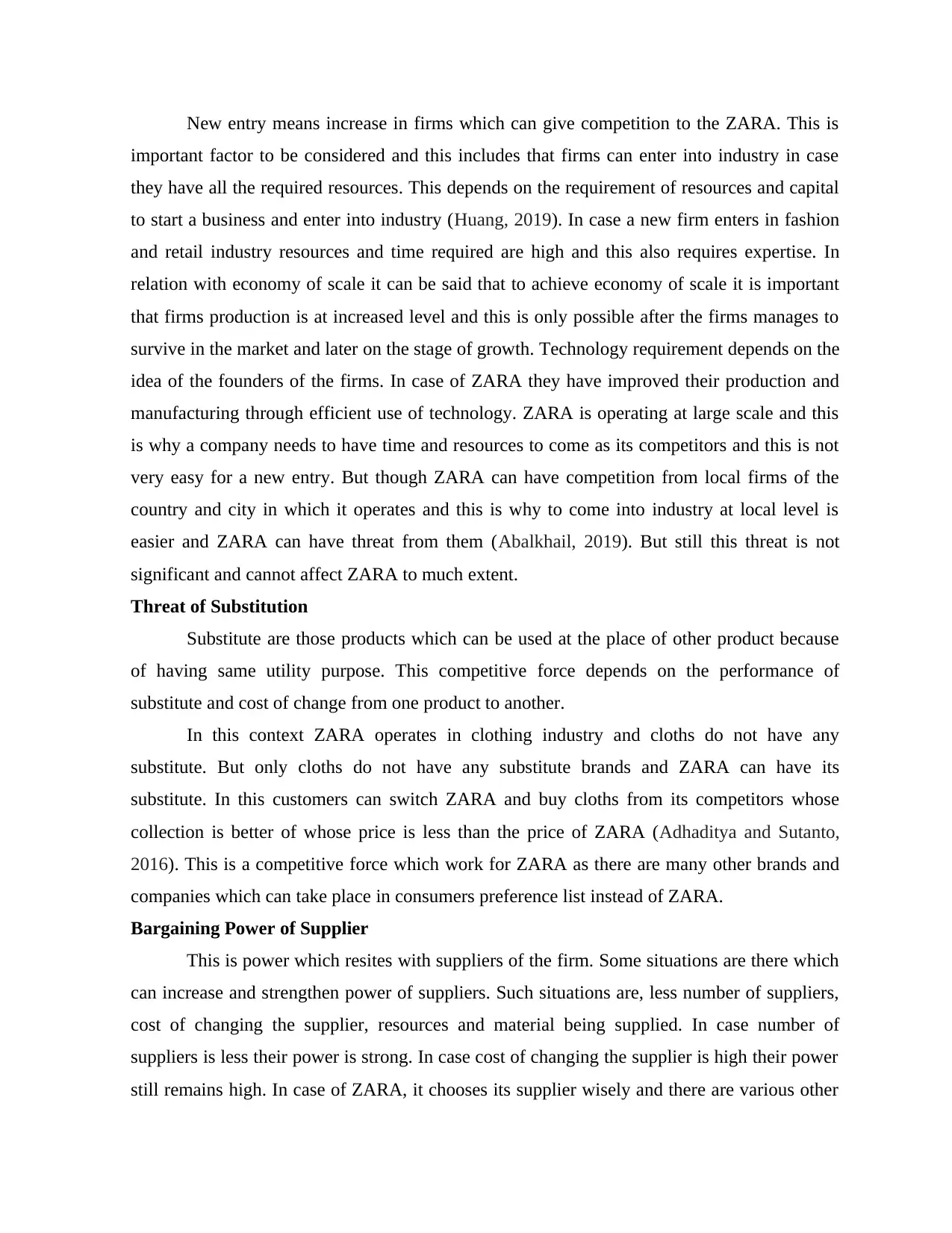
New entry means increase in firms which can give competition to the ZARA. This is
important factor to be considered and this includes that firms can enter into industry in case
they have all the required resources. This depends on the requirement of resources and capital
to start a business and enter into industry (Huang, 2019). In case a new firm enters in fashion
and retail industry resources and time required are high and this also requires expertise. In
relation with economy of scale it can be said that to achieve economy of scale it is important
that firms production is at increased level and this is only possible after the firms manages to
survive in the market and later on the stage of growth. Technology requirement depends on the
idea of the founders of the firms. In case of ZARA they have improved their production and
manufacturing through efficient use of technology. ZARA is operating at large scale and this
is why a company needs to have time and resources to come as its competitors and this is not
very easy for a new entry. But though ZARA can have competition from local firms of the
country and city in which it operates and this is why to come into industry at local level is
easier and ZARA can have threat from them (Abalkhail, 2019). But still this threat is not
significant and cannot affect ZARA to much extent.
Threat of Substitution
Substitute are those products which can be used at the place of other product because
of having same utility purpose. This competitive force depends on the performance of
substitute and cost of change from one product to another.
In this context ZARA operates in clothing industry and cloths do not have any
substitute. But only cloths do not have any substitute brands and ZARA can have its
substitute. In this customers can switch ZARA and buy cloths from its competitors whose
collection is better of whose price is less than the price of ZARA (Adhaditya and Sutanto,
2016). This is a competitive force which work for ZARA as there are many other brands and
companies which can take place in consumers preference list instead of ZARA.
Bargaining Power of Supplier
This is power which resites with suppliers of the firm. Some situations are there which
can increase and strengthen power of suppliers. Such situations are, less number of suppliers,
cost of changing the supplier, resources and material being supplied. In case number of
suppliers is less their power is strong. In case cost of changing the supplier is high their power
still remains high. In case of ZARA, it chooses its supplier wisely and there are various other
important factor to be considered and this includes that firms can enter into industry in case
they have all the required resources. This depends on the requirement of resources and capital
to start a business and enter into industry (Huang, 2019). In case a new firm enters in fashion
and retail industry resources and time required are high and this also requires expertise. In
relation with economy of scale it can be said that to achieve economy of scale it is important
that firms production is at increased level and this is only possible after the firms manages to
survive in the market and later on the stage of growth. Technology requirement depends on the
idea of the founders of the firms. In case of ZARA they have improved their production and
manufacturing through efficient use of technology. ZARA is operating at large scale and this
is why a company needs to have time and resources to come as its competitors and this is not
very easy for a new entry. But though ZARA can have competition from local firms of the
country and city in which it operates and this is why to come into industry at local level is
easier and ZARA can have threat from them (Abalkhail, 2019). But still this threat is not
significant and cannot affect ZARA to much extent.
Threat of Substitution
Substitute are those products which can be used at the place of other product because
of having same utility purpose. This competitive force depends on the performance of
substitute and cost of change from one product to another.
In this context ZARA operates in clothing industry and cloths do not have any
substitute. But only cloths do not have any substitute brands and ZARA can have its
substitute. In this customers can switch ZARA and buy cloths from its competitors whose
collection is better of whose price is less than the price of ZARA (Adhaditya and Sutanto,
2016). This is a competitive force which work for ZARA as there are many other brands and
companies which can take place in consumers preference list instead of ZARA.
Bargaining Power of Supplier
This is power which resites with suppliers of the firm. Some situations are there which
can increase and strengthen power of suppliers. Such situations are, less number of suppliers,
cost of changing the supplier, resources and material being supplied. In case number of
suppliers is less their power is strong. In case cost of changing the supplier is high their power
still remains high. In case of ZARA, it chooses its supplier wisely and there are various other
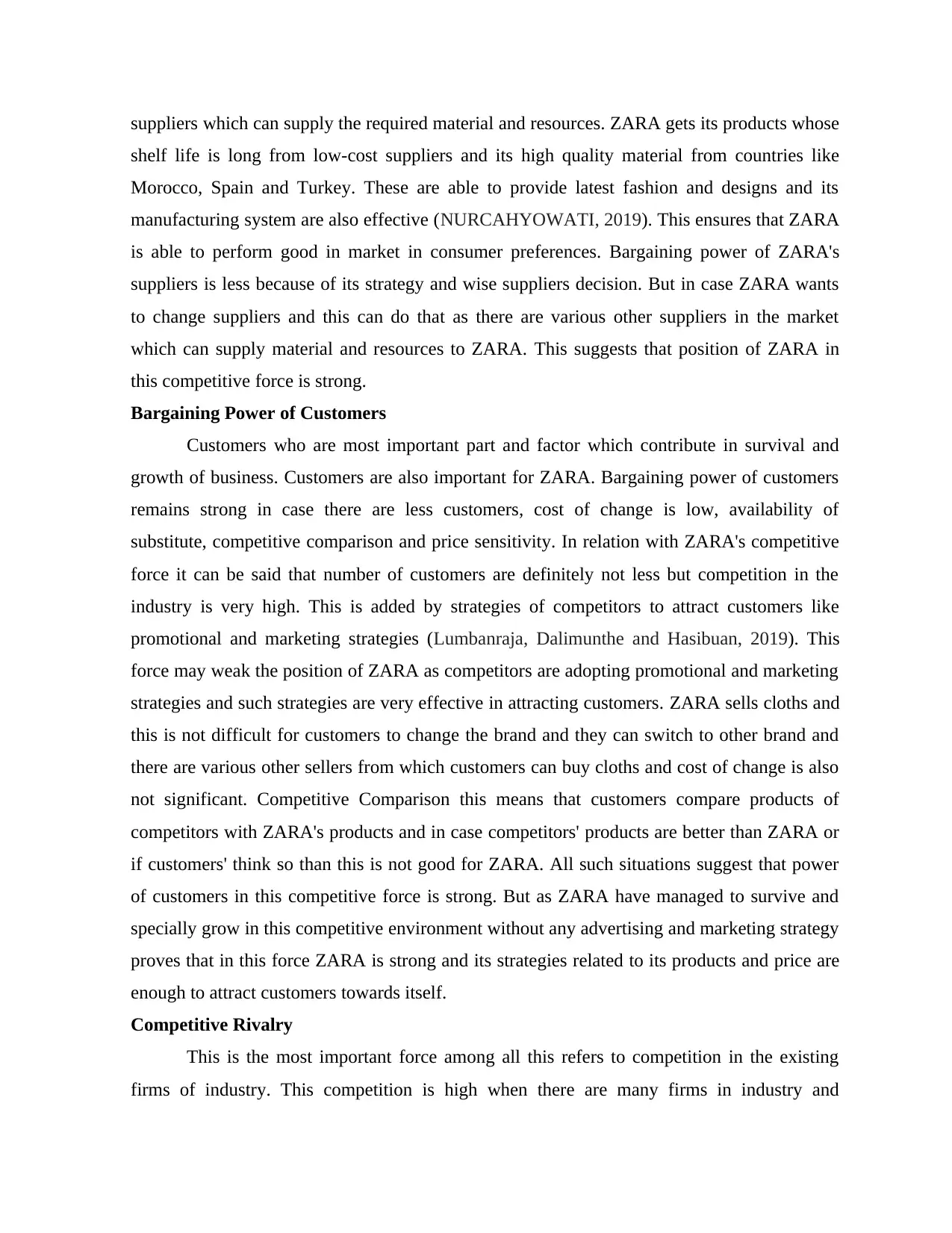
suppliers which can supply the required material and resources. ZARA gets its products whose
shelf life is long from low-cost suppliers and its high quality material from countries like
Morocco, Spain and Turkey. These are able to provide latest fashion and designs and its
manufacturing system are also effective (NURCAHYOWATI, 2019). This ensures that ZARA
is able to perform good in market in consumer preferences. Bargaining power of ZARA's
suppliers is less because of its strategy and wise suppliers decision. But in case ZARA wants
to change suppliers and this can do that as there are various other suppliers in the market
which can supply material and resources to ZARA. This suggests that position of ZARA in
this competitive force is strong.
Bargaining Power of Customers
Customers who are most important part and factor which contribute in survival and
growth of business. Customers are also important for ZARA. Bargaining power of customers
remains strong in case there are less customers, cost of change is low, availability of
substitute, competitive comparison and price sensitivity. In relation with ZARA's competitive
force it can be said that number of customers are definitely not less but competition in the
industry is very high. This is added by strategies of competitors to attract customers like
promotional and marketing strategies (Lumbanraja, Dalimunthe and Hasibuan, 2019). This
force may weak the position of ZARA as competitors are adopting promotional and marketing
strategies and such strategies are very effective in attracting customers. ZARA sells cloths and
this is not difficult for customers to change the brand and they can switch to other brand and
there are various other sellers from which customers can buy cloths and cost of change is also
not significant. Competitive Comparison this means that customers compare products of
competitors with ZARA's products and in case competitors' products are better than ZARA or
if customers' think so than this is not good for ZARA. All such situations suggest that power
of customers in this competitive force is strong. But as ZARA have managed to survive and
specially grow in this competitive environment without any advertising and marketing strategy
proves that in this force ZARA is strong and its strategies related to its products and price are
enough to attract customers towards itself.
Competitive Rivalry
This is the most important force among all this refers to competition in the existing
firms of industry. This competition is high when there are many firms in industry and
shelf life is long from low-cost suppliers and its high quality material from countries like
Morocco, Spain and Turkey. These are able to provide latest fashion and designs and its
manufacturing system are also effective (NURCAHYOWATI, 2019). This ensures that ZARA
is able to perform good in market in consumer preferences. Bargaining power of ZARA's
suppliers is less because of its strategy and wise suppliers decision. But in case ZARA wants
to change suppliers and this can do that as there are various other suppliers in the market
which can supply material and resources to ZARA. This suggests that position of ZARA in
this competitive force is strong.
Bargaining Power of Customers
Customers who are most important part and factor which contribute in survival and
growth of business. Customers are also important for ZARA. Bargaining power of customers
remains strong in case there are less customers, cost of change is low, availability of
substitute, competitive comparison and price sensitivity. In relation with ZARA's competitive
force it can be said that number of customers are definitely not less but competition in the
industry is very high. This is added by strategies of competitors to attract customers like
promotional and marketing strategies (Lumbanraja, Dalimunthe and Hasibuan, 2019). This
force may weak the position of ZARA as competitors are adopting promotional and marketing
strategies and such strategies are very effective in attracting customers. ZARA sells cloths and
this is not difficult for customers to change the brand and they can switch to other brand and
there are various other sellers from which customers can buy cloths and cost of change is also
not significant. Competitive Comparison this means that customers compare products of
competitors with ZARA's products and in case competitors' products are better than ZARA or
if customers' think so than this is not good for ZARA. All such situations suggest that power
of customers in this competitive force is strong. But as ZARA have managed to survive and
specially grow in this competitive environment without any advertising and marketing strategy
proves that in this force ZARA is strong and its strategies related to its products and price are
enough to attract customers towards itself.
Competitive Rivalry
This is the most important force among all this refers to competition in the existing
firms of industry. This competition is high when there are many firms in industry and
⊘ This is a preview!⊘
Do you want full access?
Subscribe today to unlock all pages.

Trusted by 1+ million students worldwide
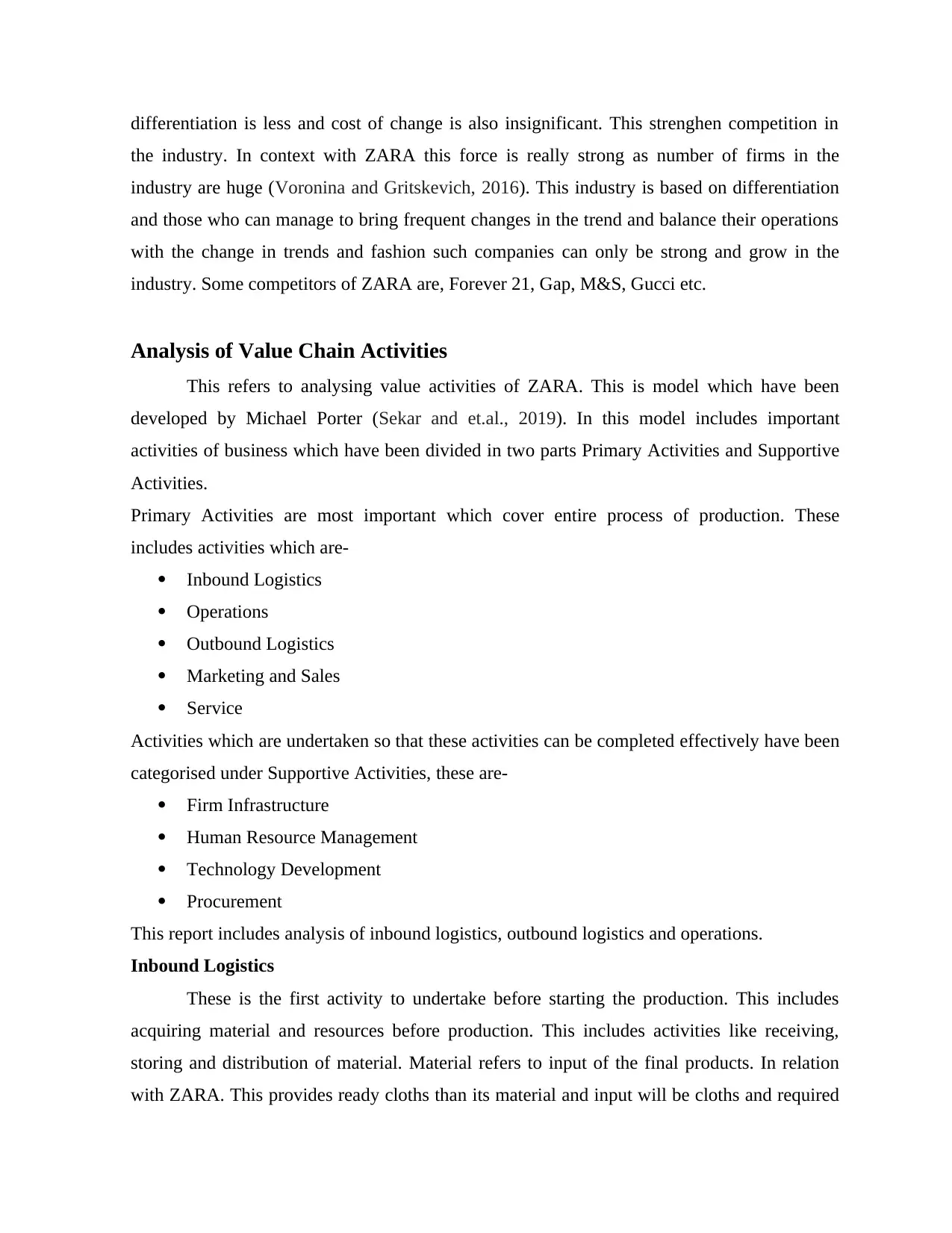
differentiation is less and cost of change is also insignificant. This strenghen competition in
the industry. In context with ZARA this force is really strong as number of firms in the
industry are huge (Voronina and Gritskevich, 2016). This industry is based on differentiation
and those who can manage to bring frequent changes in the trend and balance their operations
with the change in trends and fashion such companies can only be strong and grow in the
industry. Some competitors of ZARA are, Forever 21, Gap, M&S, Gucci etc.
Analysis of Value Chain Activities
This refers to analysing value activities of ZARA. This is model which have been
developed by Michael Porter (Sekar and et.al., 2019). In this model includes important
activities of business which have been divided in two parts Primary Activities and Supportive
Activities.
Primary Activities are most important which cover entire process of production. These
includes activities which are-
Inbound Logistics
Operations
Outbound Logistics
Marketing and Sales
Service
Activities which are undertaken so that these activities can be completed effectively have been
categorised under Supportive Activities, these are-
Firm Infrastructure
Human Resource Management
Technology Development
Procurement
This report includes analysis of inbound logistics, outbound logistics and operations.
Inbound Logistics
These is the first activity to undertake before starting the production. This includes
acquiring material and resources before production. This includes activities like receiving,
storing and distribution of material. Material refers to input of the final products. In relation
with ZARA. This provides ready cloths than its material and input will be cloths and required
the industry. In context with ZARA this force is really strong as number of firms in the
industry are huge (Voronina and Gritskevich, 2016). This industry is based on differentiation
and those who can manage to bring frequent changes in the trend and balance their operations
with the change in trends and fashion such companies can only be strong and grow in the
industry. Some competitors of ZARA are, Forever 21, Gap, M&S, Gucci etc.
Analysis of Value Chain Activities
This refers to analysing value activities of ZARA. This is model which have been
developed by Michael Porter (Sekar and et.al., 2019). In this model includes important
activities of business which have been divided in two parts Primary Activities and Supportive
Activities.
Primary Activities are most important which cover entire process of production. These
includes activities which are-
Inbound Logistics
Operations
Outbound Logistics
Marketing and Sales
Service
Activities which are undertaken so that these activities can be completed effectively have been
categorised under Supportive Activities, these are-
Firm Infrastructure
Human Resource Management
Technology Development
Procurement
This report includes analysis of inbound logistics, outbound logistics and operations.
Inbound Logistics
These is the first activity to undertake before starting the production. This includes
acquiring material and resources before production. This includes activities like receiving,
storing and distribution of material. Material refers to input of the final products. In relation
with ZARA. This provides ready cloths than its material and input will be cloths and required
Paraphrase This Document
Need a fresh take? Get an instant paraphrase of this document with our AI Paraphraser
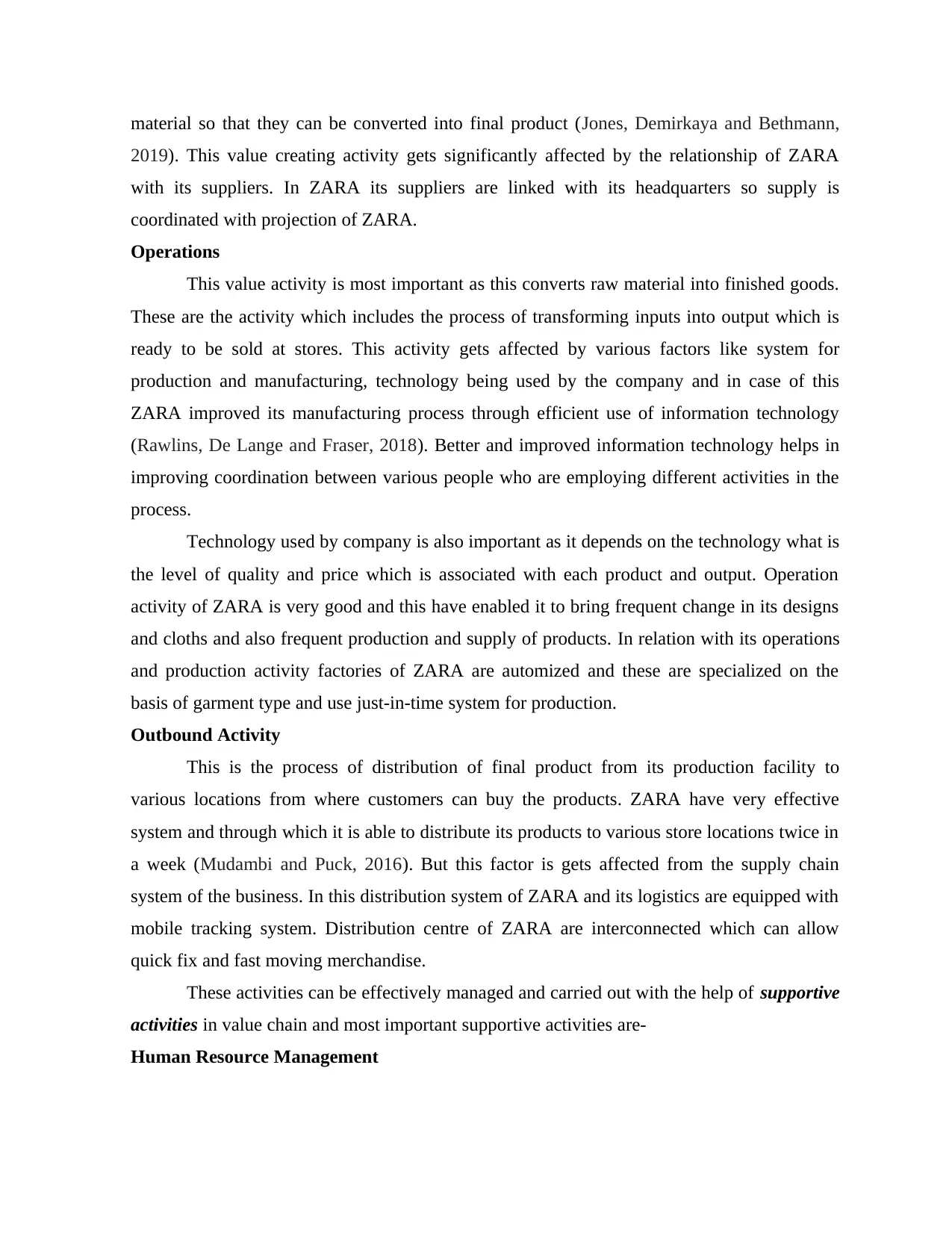
material so that they can be converted into final product (Jones, Demirkaya and Bethmann,
2019). This value creating activity gets significantly affected by the relationship of ZARA
with its suppliers. In ZARA its suppliers are linked with its headquarters so supply is
coordinated with projection of ZARA.
Operations
This value activity is most important as this converts raw material into finished goods.
These are the activity which includes the process of transforming inputs into output which is
ready to be sold at stores. This activity gets affected by various factors like system for
production and manufacturing, technology being used by the company and in case of this
ZARA improved its manufacturing process through efficient use of information technology
(Rawlins, De Lange and Fraser, 2018). Better and improved information technology helps in
improving coordination between various people who are employing different activities in the
process.
Technology used by company is also important as it depends on the technology what is
the level of quality and price which is associated with each product and output. Operation
activity of ZARA is very good and this have enabled it to bring frequent change in its designs
and cloths and also frequent production and supply of products. In relation with its operations
and production activity factories of ZARA are automized and these are specialized on the
basis of garment type and use just-in-time system for production.
Outbound Activity
This is the process of distribution of final product from its production facility to
various locations from where customers can buy the products. ZARA have very effective
system and through which it is able to distribute its products to various store locations twice in
a week (Mudambi and Puck, 2016). But this factor is gets affected from the supply chain
system of the business. In this distribution system of ZARA and its logistics are equipped with
mobile tracking system. Distribution centre of ZARA are interconnected which can allow
quick fix and fast moving merchandise.
These activities can be effectively managed and carried out with the help of supportive
activities in value chain and most important supportive activities are-
Human Resource Management
2019). This value creating activity gets significantly affected by the relationship of ZARA
with its suppliers. In ZARA its suppliers are linked with its headquarters so supply is
coordinated with projection of ZARA.
Operations
This value activity is most important as this converts raw material into finished goods.
These are the activity which includes the process of transforming inputs into output which is
ready to be sold at stores. This activity gets affected by various factors like system for
production and manufacturing, technology being used by the company and in case of this
ZARA improved its manufacturing process through efficient use of information technology
(Rawlins, De Lange and Fraser, 2018). Better and improved information technology helps in
improving coordination between various people who are employing different activities in the
process.
Technology used by company is also important as it depends on the technology what is
the level of quality and price which is associated with each product and output. Operation
activity of ZARA is very good and this have enabled it to bring frequent change in its designs
and cloths and also frequent production and supply of products. In relation with its operations
and production activity factories of ZARA are automized and these are specialized on the
basis of garment type and use just-in-time system for production.
Outbound Activity
This is the process of distribution of final product from its production facility to
various locations from where customers can buy the products. ZARA have very effective
system and through which it is able to distribute its products to various store locations twice in
a week (Mudambi and Puck, 2016). But this factor is gets affected from the supply chain
system of the business. In this distribution system of ZARA and its logistics are equipped with
mobile tracking system. Distribution centre of ZARA are interconnected which can allow
quick fix and fast moving merchandise.
These activities can be effectively managed and carried out with the help of supportive
activities in value chain and most important supportive activities are-
Human Resource Management
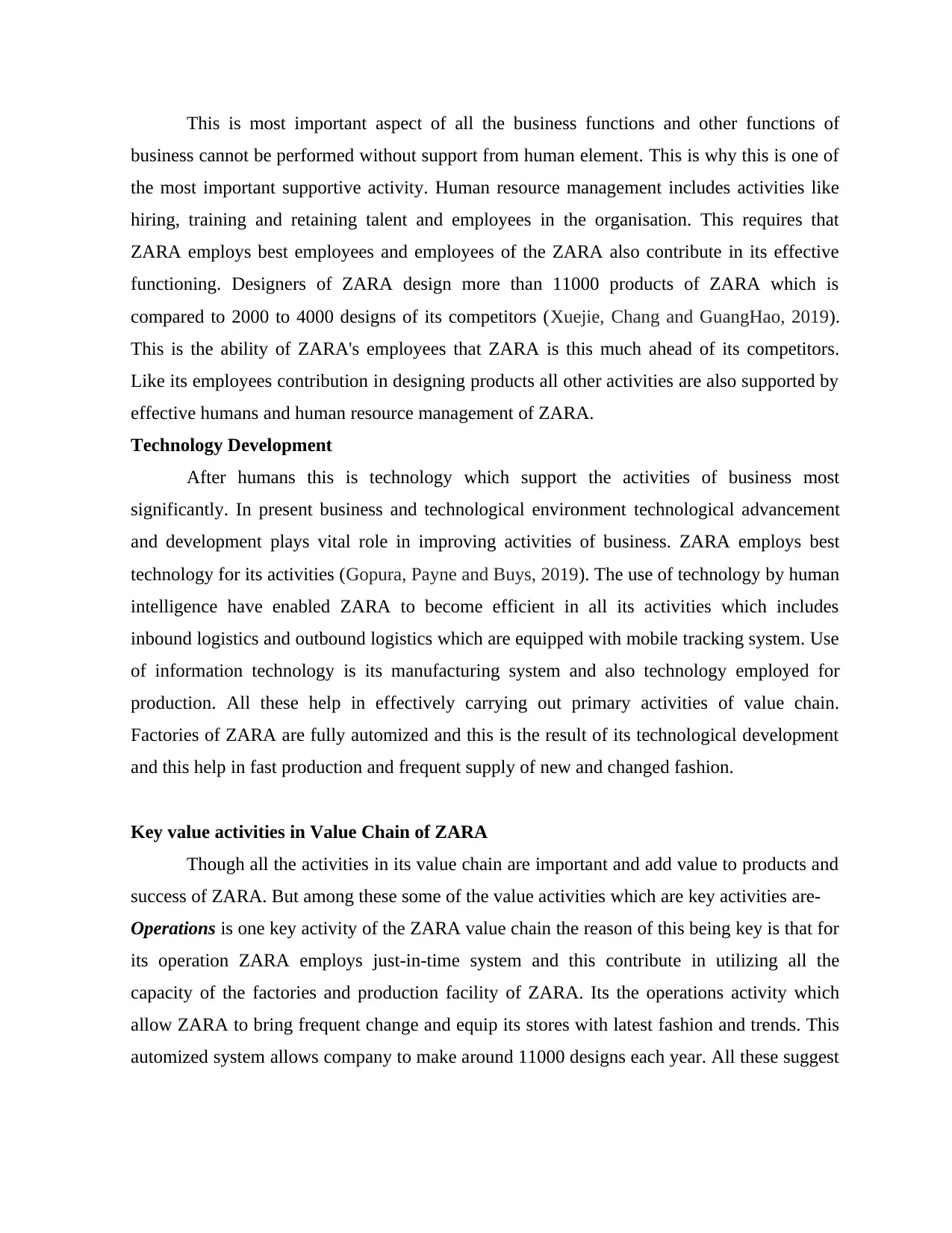
This is most important aspect of all the business functions and other functions of
business cannot be performed without support from human element. This is why this is one of
the most important supportive activity. Human resource management includes activities like
hiring, training and retaining talent and employees in the organisation. This requires that
ZARA employs best employees and employees of the ZARA also contribute in its effective
functioning. Designers of ZARA design more than 11000 products of ZARA which is
compared to 2000 to 4000 designs of its competitors (Xuejie, Chang and GuangHao, 2019).
This is the ability of ZARA's employees that ZARA is this much ahead of its competitors.
Like its employees contribution in designing products all other activities are also supported by
effective humans and human resource management of ZARA.
Technology Development
After humans this is technology which support the activities of business most
significantly. In present business and technological environment technological advancement
and development plays vital role in improving activities of business. ZARA employs best
technology for its activities (Gopura, Payne and Buys, 2019). The use of technology by human
intelligence have enabled ZARA to become efficient in all its activities which includes
inbound logistics and outbound logistics which are equipped with mobile tracking system. Use
of information technology is its manufacturing system and also technology employed for
production. All these help in effectively carrying out primary activities of value chain.
Factories of ZARA are fully automized and this is the result of its technological development
and this help in fast production and frequent supply of new and changed fashion.
Key value activities in Value Chain of ZARA
Though all the activities in its value chain are important and add value to products and
success of ZARA. But among these some of the value activities which are key activities are-
Operations is one key activity of the ZARA value chain the reason of this being key is that for
its operation ZARA employs just-in-time system and this contribute in utilizing all the
capacity of the factories and production facility of ZARA. Its the operations activity which
allow ZARA to bring frequent change and equip its stores with latest fashion and trends. This
automized system allows company to make around 11000 designs each year. All these suggest
business cannot be performed without support from human element. This is why this is one of
the most important supportive activity. Human resource management includes activities like
hiring, training and retaining talent and employees in the organisation. This requires that
ZARA employs best employees and employees of the ZARA also contribute in its effective
functioning. Designers of ZARA design more than 11000 products of ZARA which is
compared to 2000 to 4000 designs of its competitors (Xuejie, Chang and GuangHao, 2019).
This is the ability of ZARA's employees that ZARA is this much ahead of its competitors.
Like its employees contribution in designing products all other activities are also supported by
effective humans and human resource management of ZARA.
Technology Development
After humans this is technology which support the activities of business most
significantly. In present business and technological environment technological advancement
and development plays vital role in improving activities of business. ZARA employs best
technology for its activities (Gopura, Payne and Buys, 2019). The use of technology by human
intelligence have enabled ZARA to become efficient in all its activities which includes
inbound logistics and outbound logistics which are equipped with mobile tracking system. Use
of information technology is its manufacturing system and also technology employed for
production. All these help in effectively carrying out primary activities of value chain.
Factories of ZARA are fully automized and this is the result of its technological development
and this help in fast production and frequent supply of new and changed fashion.
Key value activities in Value Chain of ZARA
Though all the activities in its value chain are important and add value to products and
success of ZARA. But among these some of the value activities which are key activities are-
Operations is one key activity of the ZARA value chain the reason of this being key is that for
its operation ZARA employs just-in-time system and this contribute in utilizing all the
capacity of the factories and production facility of ZARA. Its the operations activity which
allow ZARA to bring frequent change and equip its stores with latest fashion and trends. This
automized system allows company to make around 11000 designs each year. All these suggest
⊘ This is a preview!⊘
Do you want full access?
Subscribe today to unlock all pages.

Trusted by 1+ million students worldwide
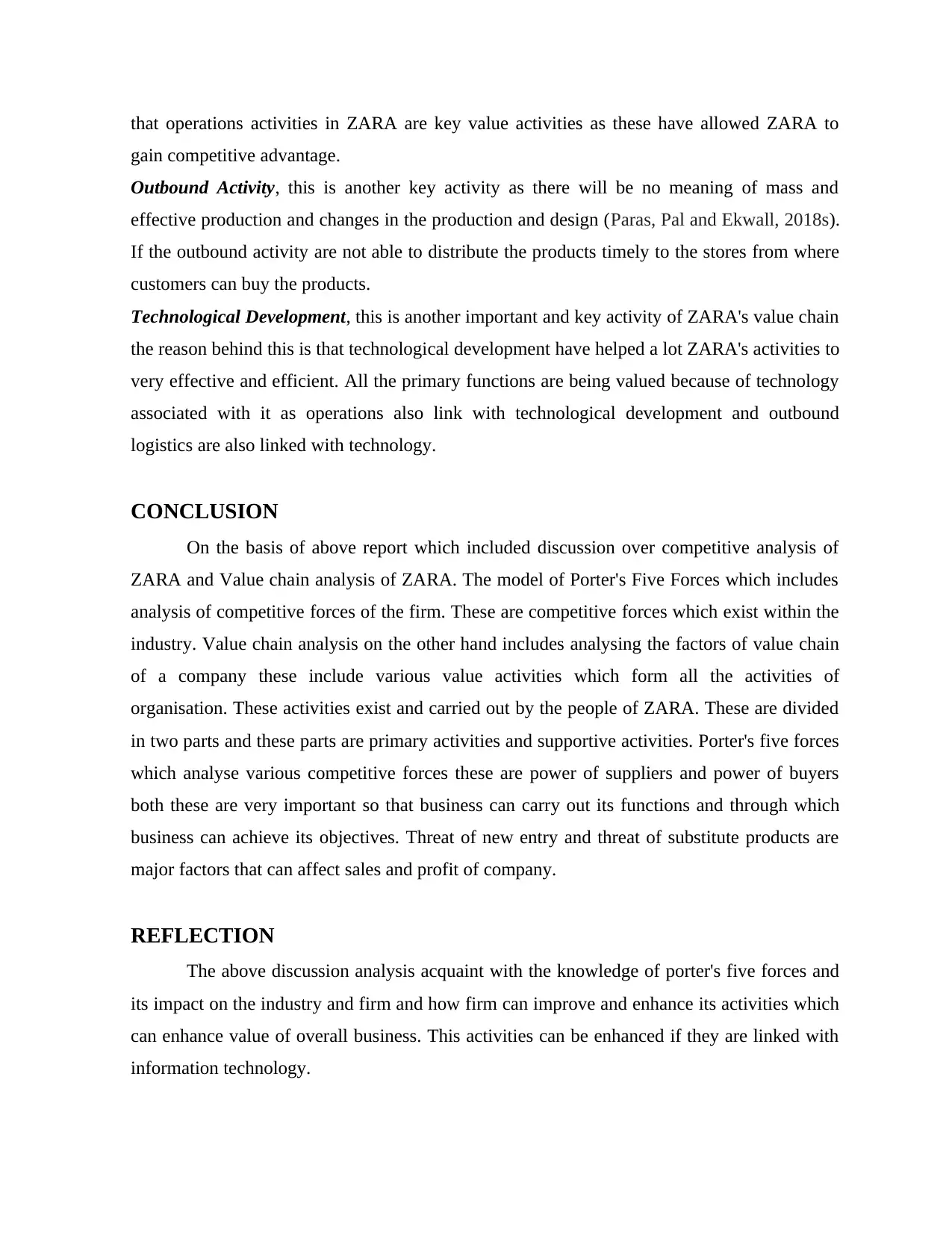
that operations activities in ZARA are key value activities as these have allowed ZARA to
gain competitive advantage.
Outbound Activity, this is another key activity as there will be no meaning of mass and
effective production and changes in the production and design (Paras, Pal and Ekwall, 2018s).
If the outbound activity are not able to distribute the products timely to the stores from where
customers can buy the products.
Technological Development, this is another important and key activity of ZARA's value chain
the reason behind this is that technological development have helped a lot ZARA's activities to
very effective and efficient. All the primary functions are being valued because of technology
associated with it as operations also link with technological development and outbound
logistics are also linked with technology.
CONCLUSION
On the basis of above report which included discussion over competitive analysis of
ZARA and Value chain analysis of ZARA. The model of Porter's Five Forces which includes
analysis of competitive forces of the firm. These are competitive forces which exist within the
industry. Value chain analysis on the other hand includes analysing the factors of value chain
of a company these include various value activities which form all the activities of
organisation. These activities exist and carried out by the people of ZARA. These are divided
in two parts and these parts are primary activities and supportive activities. Porter's five forces
which analyse various competitive forces these are power of suppliers and power of buyers
both these are very important so that business can carry out its functions and through which
business can achieve its objectives. Threat of new entry and threat of substitute products are
major factors that can affect sales and profit of company.
REFLECTION
The above discussion analysis acquaint with the knowledge of porter's five forces and
its impact on the industry and firm and how firm can improve and enhance its activities which
can enhance value of overall business. This activities can be enhanced if they are linked with
information technology.
gain competitive advantage.
Outbound Activity, this is another key activity as there will be no meaning of mass and
effective production and changes in the production and design (Paras, Pal and Ekwall, 2018s).
If the outbound activity are not able to distribute the products timely to the stores from where
customers can buy the products.
Technological Development, this is another important and key activity of ZARA's value chain
the reason behind this is that technological development have helped a lot ZARA's activities to
very effective and efficient. All the primary functions are being valued because of technology
associated with it as operations also link with technological development and outbound
logistics are also linked with technology.
CONCLUSION
On the basis of above report which included discussion over competitive analysis of
ZARA and Value chain analysis of ZARA. The model of Porter's Five Forces which includes
analysis of competitive forces of the firm. These are competitive forces which exist within the
industry. Value chain analysis on the other hand includes analysing the factors of value chain
of a company these include various value activities which form all the activities of
organisation. These activities exist and carried out by the people of ZARA. These are divided
in two parts and these parts are primary activities and supportive activities. Porter's five forces
which analyse various competitive forces these are power of suppliers and power of buyers
both these are very important so that business can carry out its functions and through which
business can achieve its objectives. Threat of new entry and threat of substitute products are
major factors that can affect sales and profit of company.
REFLECTION
The above discussion analysis acquaint with the knowledge of porter's five forces and
its impact on the industry and firm and how firm can improve and enhance its activities which
can enhance value of overall business. This activities can be enhanced if they are linked with
information technology.
Paraphrase This Document
Need a fresh take? Get an instant paraphrase of this document with our AI Paraphraser
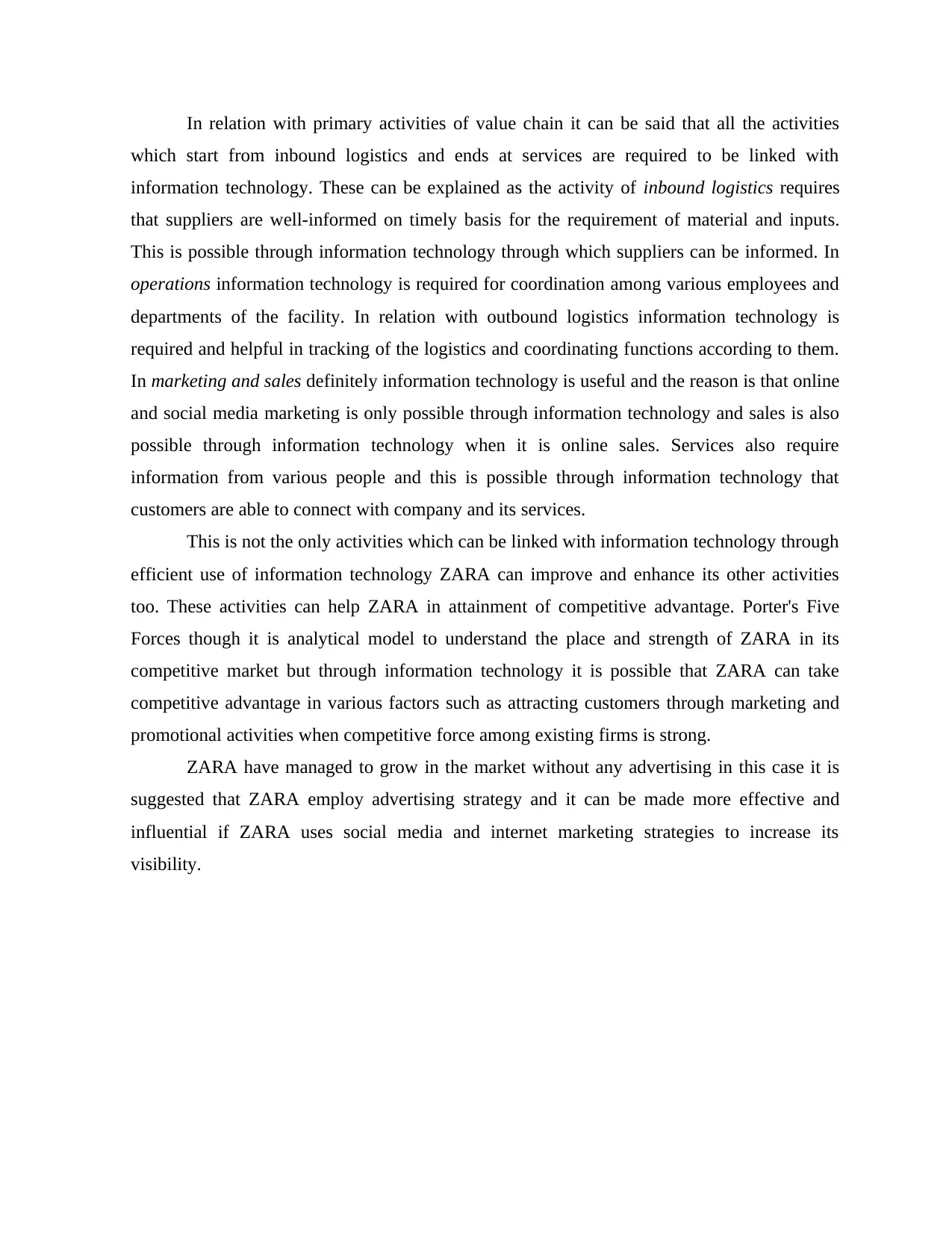
In relation with primary activities of value chain it can be said that all the activities
which start from inbound logistics and ends at services are required to be linked with
information technology. These can be explained as the activity of inbound logistics requires
that suppliers are well-informed on timely basis for the requirement of material and inputs.
This is possible through information technology through which suppliers can be informed. In
operations information technology is required for coordination among various employees and
departments of the facility. In relation with outbound logistics information technology is
required and helpful in tracking of the logistics and coordinating functions according to them.
In marketing and sales definitely information technology is useful and the reason is that online
and social media marketing is only possible through information technology and sales is also
possible through information technology when it is online sales. Services also require
information from various people and this is possible through information technology that
customers are able to connect with company and its services.
This is not the only activities which can be linked with information technology through
efficient use of information technology ZARA can improve and enhance its other activities
too. These activities can help ZARA in attainment of competitive advantage. Porter's Five
Forces though it is analytical model to understand the place and strength of ZARA in its
competitive market but through information technology it is possible that ZARA can take
competitive advantage in various factors such as attracting customers through marketing and
promotional activities when competitive force among existing firms is strong.
ZARA have managed to grow in the market without any advertising in this case it is
suggested that ZARA employ advertising strategy and it can be made more effective and
influential if ZARA uses social media and internet marketing strategies to increase its
visibility.
which start from inbound logistics and ends at services are required to be linked with
information technology. These can be explained as the activity of inbound logistics requires
that suppliers are well-informed on timely basis for the requirement of material and inputs.
This is possible through information technology through which suppliers can be informed. In
operations information technology is required for coordination among various employees and
departments of the facility. In relation with outbound logistics information technology is
required and helpful in tracking of the logistics and coordinating functions according to them.
In marketing and sales definitely information technology is useful and the reason is that online
and social media marketing is only possible through information technology and sales is also
possible through information technology when it is online sales. Services also require
information from various people and this is possible through information technology that
customers are able to connect with company and its services.
This is not the only activities which can be linked with information technology through
efficient use of information technology ZARA can improve and enhance its other activities
too. These activities can help ZARA in attainment of competitive advantage. Porter's Five
Forces though it is analytical model to understand the place and strength of ZARA in its
competitive market but through information technology it is possible that ZARA can take
competitive advantage in various factors such as attracting customers through marketing and
promotional activities when competitive force among existing firms is strong.
ZARA have managed to grow in the market without any advertising in this case it is
suggested that ZARA employ advertising strategy and it can be made more effective and
influential if ZARA uses social media and internet marketing strategies to increase its
visibility.
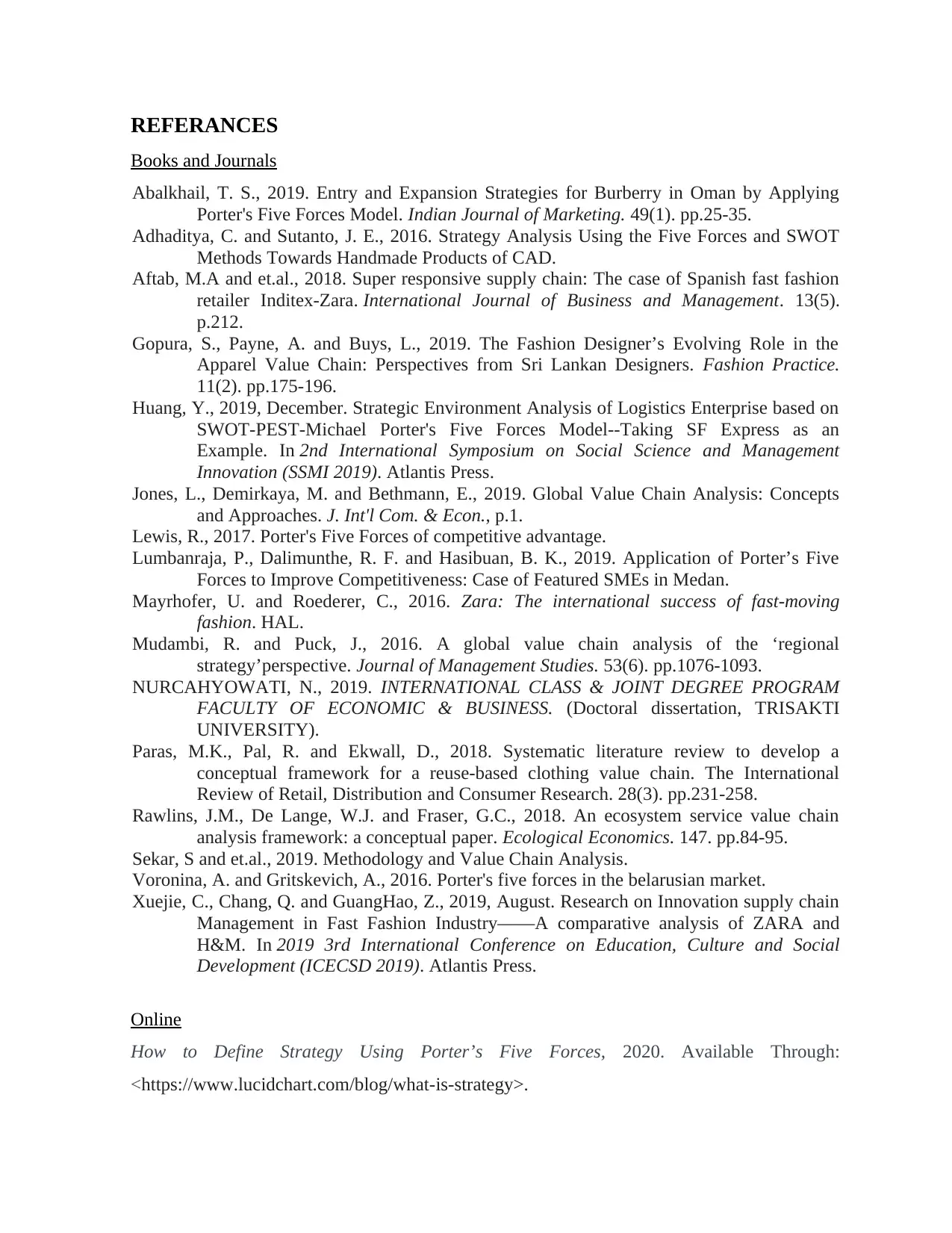
REFERANCES
Books and Journals
Abalkhail, T. S., 2019. Entry and Expansion Strategies for Burberry in Oman by Applying
Porter's Five Forces Model. Indian Journal of Marketing. 49(1). pp.25-35.
Adhaditya, C. and Sutanto, J. E., 2016. Strategy Analysis Using the Five Forces and SWOT
Methods Towards Handmade Products of CAD.
Aftab, M.A and et.al., 2018. Super responsive supply chain: The case of Spanish fast fashion
retailer Inditex-Zara. International Journal of Business and Management. 13(5).
p.212.
Gopura, S., Payne, A. and Buys, L., 2019. The Fashion Designer’s Evolving Role in the
Apparel Value Chain: Perspectives from Sri Lankan Designers. Fashion Practice.
11(2). pp.175-196.
Huang, Y., 2019, December. Strategic Environment Analysis of Logistics Enterprise based on
SWOT-PEST-Michael Porter's Five Forces Model--Taking SF Express as an
Example. In 2nd International Symposium on Social Science and Management
Innovation (SSMI 2019). Atlantis Press.
Jones, L., Demirkaya, M. and Bethmann, E., 2019. Global Value Chain Analysis: Concepts
and Approaches. J. Int'l Com. & Econ., p.1.
Lewis, R., 2017. Porter's Five Forces of competitive advantage.
Lumbanraja, P., Dalimunthe, R. F. and Hasibuan, B. K., 2019. Application of Porter’s Five
Forces to Improve Competitiveness: Case of Featured SMEs in Medan.
Mayrhofer, U. and Roederer, C., 2016. Zara: The international success of fast-moving
fashion. HAL.
Mudambi, R. and Puck, J., 2016. A global value chain analysis of the ‘regional
strategy’perspective. Journal of Management Studies. 53(6). pp.1076-1093.
NURCAHYOWATI, N., 2019. INTERNATIONAL CLASS & JOINT DEGREE PROGRAM
FACULTY OF ECONOMIC & BUSINESS. (Doctoral dissertation, TRISAKTI
UNIVERSITY).
Paras, M.K., Pal, R. and Ekwall, D., 2018. Systematic literature review to develop a
conceptual framework for a reuse-based clothing value chain. The International
Review of Retail, Distribution and Consumer Research. 28(3). pp.231-258.
Rawlins, J.M., De Lange, W.J. and Fraser, G.C., 2018. An ecosystem service value chain
analysis framework: a conceptual paper. Ecological Economics. 147. pp.84-95.
Sekar, S and et.al., 2019. Methodology and Value Chain Analysis.
Voronina, A. and Gritskevich, A., 2016. Porter's five forces in the belarusian market.
Xuejie, C., Chang, Q. and GuangHao, Z., 2019, August. Research on Innovation supply chain
Management in Fast Fashion Industry——A comparative analysis of ZARA and
H&M. In 2019 3rd International Conference on Education, Culture and Social
Development (ICECSD 2019). Atlantis Press.
Online
How to Define Strategy Using Porter’s Five Forces, 2020. Available Through:
<https://www.lucidchart.com/blog/what-is-strategy>.
Books and Journals
Abalkhail, T. S., 2019. Entry and Expansion Strategies for Burberry in Oman by Applying
Porter's Five Forces Model. Indian Journal of Marketing. 49(1). pp.25-35.
Adhaditya, C. and Sutanto, J. E., 2016. Strategy Analysis Using the Five Forces and SWOT
Methods Towards Handmade Products of CAD.
Aftab, M.A and et.al., 2018. Super responsive supply chain: The case of Spanish fast fashion
retailer Inditex-Zara. International Journal of Business and Management. 13(5).
p.212.
Gopura, S., Payne, A. and Buys, L., 2019. The Fashion Designer’s Evolving Role in the
Apparel Value Chain: Perspectives from Sri Lankan Designers. Fashion Practice.
11(2). pp.175-196.
Huang, Y., 2019, December. Strategic Environment Analysis of Logistics Enterprise based on
SWOT-PEST-Michael Porter's Five Forces Model--Taking SF Express as an
Example. In 2nd International Symposium on Social Science and Management
Innovation (SSMI 2019). Atlantis Press.
Jones, L., Demirkaya, M. and Bethmann, E., 2019. Global Value Chain Analysis: Concepts
and Approaches. J. Int'l Com. & Econ., p.1.
Lewis, R., 2017. Porter's Five Forces of competitive advantage.
Lumbanraja, P., Dalimunthe, R. F. and Hasibuan, B. K., 2019. Application of Porter’s Five
Forces to Improve Competitiveness: Case of Featured SMEs in Medan.
Mayrhofer, U. and Roederer, C., 2016. Zara: The international success of fast-moving
fashion. HAL.
Mudambi, R. and Puck, J., 2016. A global value chain analysis of the ‘regional
strategy’perspective. Journal of Management Studies. 53(6). pp.1076-1093.
NURCAHYOWATI, N., 2019. INTERNATIONAL CLASS & JOINT DEGREE PROGRAM
FACULTY OF ECONOMIC & BUSINESS. (Doctoral dissertation, TRISAKTI
UNIVERSITY).
Paras, M.K., Pal, R. and Ekwall, D., 2018. Systematic literature review to develop a
conceptual framework for a reuse-based clothing value chain. The International
Review of Retail, Distribution and Consumer Research. 28(3). pp.231-258.
Rawlins, J.M., De Lange, W.J. and Fraser, G.C., 2018. An ecosystem service value chain
analysis framework: a conceptual paper. Ecological Economics. 147. pp.84-95.
Sekar, S and et.al., 2019. Methodology and Value Chain Analysis.
Voronina, A. and Gritskevich, A., 2016. Porter's five forces in the belarusian market.
Xuejie, C., Chang, Q. and GuangHao, Z., 2019, August. Research on Innovation supply chain
Management in Fast Fashion Industry——A comparative analysis of ZARA and
H&M. In 2019 3rd International Conference on Education, Culture and Social
Development (ICECSD 2019). Atlantis Press.
Online
How to Define Strategy Using Porter’s Five Forces, 2020. Available Through:
<https://www.lucidchart.com/blog/what-is-strategy>.
⊘ This is a preview!⊘
Do you want full access?
Subscribe today to unlock all pages.

Trusted by 1+ million students worldwide
1 out of 12
Related Documents
Your All-in-One AI-Powered Toolkit for Academic Success.
+13062052269
info@desklib.com
Available 24*7 on WhatsApp / Email
![[object Object]](/_next/static/media/star-bottom.7253800d.svg)
Unlock your academic potential
Copyright © 2020–2025 A2Z Services. All Rights Reserved. Developed and managed by ZUCOL.




